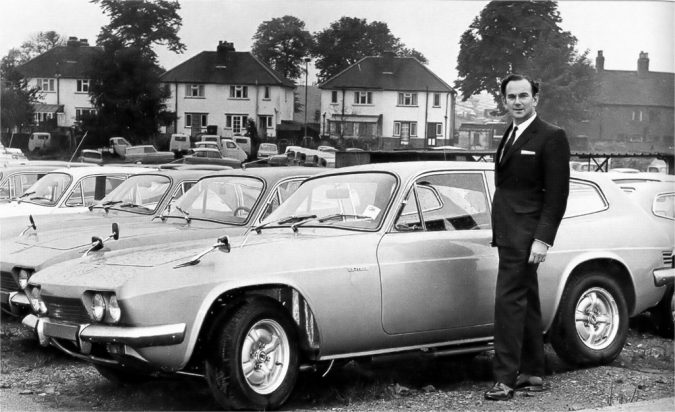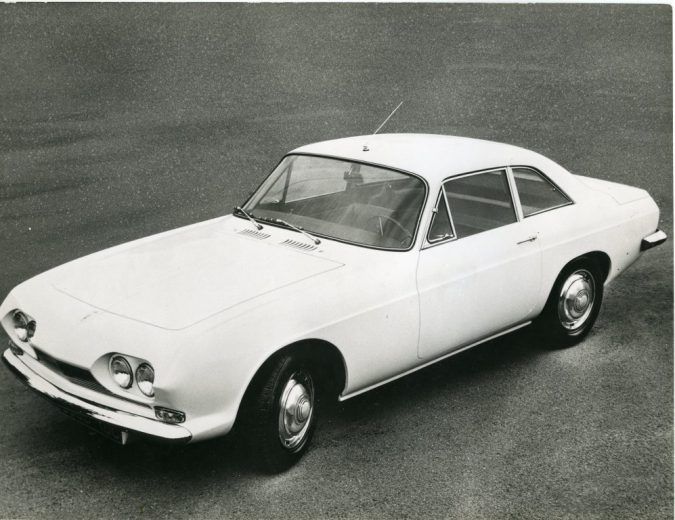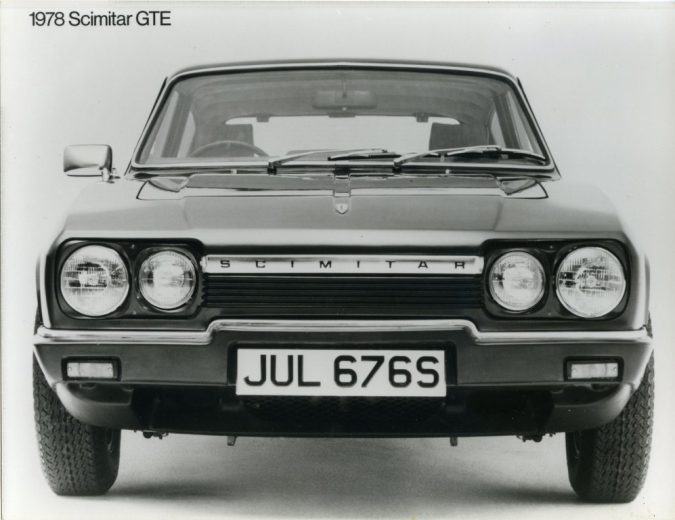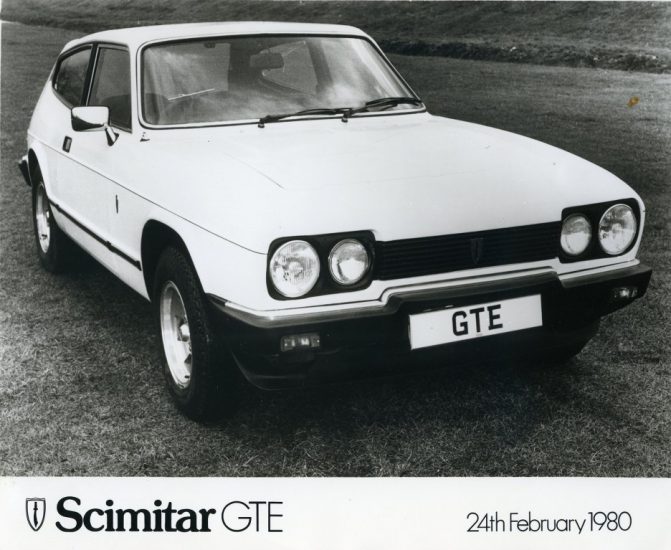As well as my own research and the kind help of various societies and clubs (the RMC, in particular, including my thanks for the featured image), and the previously-mentioned newspaper articles, I have also used the book Reliant Sports Cars by Don Pither to get a good grasp of the Scimitar and its impact when it was released.
It’s now 50 years since that time. I find it incredible – and somewhat shocking – how much information can be lost in such short time. Because of this, I’ve needed all the help I could get.
Reliant Sports Cars was first published in 2000 by Sutton Publishing Limited, featuring a foreword from my Grandpa, Ray Wiggin, written in November 1999, which was about the time I turned two. Grandpa – Ray – was the managing director of Reliant in the 1960s and 70s, during its peak years.
It features such an impressively wide array of vivid pictures that it’s easy to become distracted from the thoroughly-researched text. Mr Pither’s hard work has been incredibly useful to me as I’ve been putting this article together.
Elvis Payne’s book, The Reliant Scimitar, also picks up where Don Pither leaves off. Together, these two books give a detailed view of the Scimitar (and Sabre) through the years.
Reliant – The Car Company
Reliant, as a car company, was best known for its three-wheelers, most notably the Robin.
If you’re unfamiliar with Reliant and assume that the Robin was the sole product in its range, think again.
They produced far more than just three-wheelers. The Scimitar was the pinnacle of Reliant’s sporting heritage and, if things had gone differently, may have been the first of many of its kind. Unfortunately, things went the way they did, and the Scimitar is, nowadays, a nod back to better days.
Specialising in fibreglass production, Reliant looked for niches in the market they could fill. The Scimitar was no exception to this rule and this is likely why it was so successful.

Grandpa with Scimitar GTEs at Tamworth. Used with the kind permission of the Reliant Motor Club.
The Reliant Scimitar’s Roots
Those who know the story of the Scimitar know its reputation. It was the first of its kind, a groundbreaking car, paving the way for many of the greats. Today, it’s still recognisable in the same way one might view a champion boxer from the same era: a monstrous great in its day, respected timelessly.
For the Scimitar, its life stemmed from the Reliant Sabre. The Sabre itself requires a whole article dedicated to it, but I’ll try to summarise it here briefly.
In short, Reliant worked with Mr Itzhak Shubinsky, the MD of Autocars Limited, Haifa, Israel. In 1960, Israel was still a very young country (only 12 years old) and had already fought in at least three wars, and so the economy needed as much boosting as possible.
Mr Shubinsky visited the London Racing Car Show in January of 1960 and saw, on two different respective stands:
- a simple chassis, designed and made by LMB Components, and
- a glass-fibre sports-car-style body, from Ashley Associates.
He then went to Reliant and wanted them to use the two designs, throw them together, and produce a car within twelve months. Usually, a car’s production process is between three and five years, and so it’s easy to understand how Grandpa described Mr Shubinsky as “our man in a hurry”.
Eventually, the work with Autocars in Israel brought a car to the market in the US. It was originally named a Sabra – a cactus from Israel and also a term applied to an Israeli native – but Reliant anglicised it to “Sabre”. After failing in the American market, Reliant decided to try releasing it to the British people. The Sabre sold, but very slowly.
It was, though, a very good car, and hasn’t really been given the due time and appreciation it deserved. Reliant even had a rally team that took the Sabre to the Monte Carlo rally, among others!
The Scimitar GT was the natural successor of the Sabre 6, which was a significant evolution from the Sabre 4.
Reliant Scimitar – Early Design
Designed by Tom Karen, head of the design team at David Ogle Ltd, the Scimitar GT was seen by many as a much more visually-pleasing car than the Sabre 6.
(Personally, I find the Sabre one of the prettiest cars ever made, but that’s something for another article. Some would disagree, and the market at the time certainly seemed to.)
The early GT sold reasonably well, but there was more ground to be made.
In the introduction to Reliant Sports Cars by Don Pither, Grandpa writes
…Reliant was looking for a solution to satisfy a perceived demand for a design of sports saloon that could provide reasonable accommodation for four people as well as lots of luggage…
After using market research to identify a gap in the market for up to 50,000 of this type of vehicle, the design phase began. One of the most important design points was that the car had to be a true four-seater. Although the GT could technically fit four people, the back could only realistically accommodate children. Many of the first mock-ups were instantly dismissed as they “looked more like a GT version of a funeral hearse”.
Eventually, the Scimitar GTE was born. Grandpa – Ray – went to view a full-size concept design based on the Scimitar GT in October 1967, again produced by Tom Karen with Ogle. When he saw the GTE mock-up, he was instantly taken. He writes that the design was “brilliant” and gave it the go-ahead immediately.
The rest is history.
Reliant Scimitar Models
The Sabre and the Scimitar are part of the same family, bearing the same model name – “SE”.
(“SE” comes from the name “Sabre” – “SabrE“.)
The SE1 (Sabre 4) and SE2 (Sabre 6) were produced in 1961 and 1962 respectively, but only 285 of these combined were produced.
The SE3 project was abandoned. Following that, the SE4 and beyond represented the Reliant Scimitar in various forms.
- SE4 – Scimitar Coupe (Straight-6).
- SE4a/b – Scimitar Coupe (3-litre V6).
- SE4c – Scimitar Coupe (2.5-litre V6).
- SE5 – Scimitar GTE (3-litre).
- SE5a – Scimitar GTE, uprated.
- SE6 – Scimitar GTE, enlarged.
- SE6a – an improved version of the SE6.
- SE6b – Scimitar GTE (2.8-litre).
- SE8b – Scimitar GTC convertible (2.8-litre). (Grandpa’s final project at Reliant.)
Of these Scimitars (specifically), of which the SE5 (1968) and SE6 versions were the most popular (by far), around 15,721 cars were produced. A good number of them survive to this day because, of course, they are far less prone to rust than most cars of their day.
(Note: “GTE” stands for “Grand Touring Estate”.)

Reliant Scimitar GT. Used with the kind permission of the Reliant Motor Club.
A few other projects, such as the abandoned SE7 (which would have been a four-door Scimitar GTE SE6, see below) and SE8 prototype also came out around this time – the late 70s and early 80s.
In 1987, Middlebridge acquired the rights for the Scimitar GTE and convertible GTC for £400,000. Between 1988 and 1990, the company made 78 Middlebridge Scimitar GTEs before it sadly went into receivership. The Middlebridge Scimitar had a 150 bhp 2.9-litre engine.
Nowadays, the production rights for the Scimitar belong to Graham Walker Ltd.
Abandoned SE7 Project
The SE7 was based on the Bertone-styled FW11 that was originally designed to replace the Anadol FW5 in Turkey, but was considered as a replacement for the SE6b. Reliant built a few test models but never used the design. You can occasionally see the prototype in the Rahmi M. Koç Museum in Istanbul (Koç Holding A.S. jointly owns Otosan with Ford).
It was to rear its head again a few years later as the Citroen BX, a car which has been widely credited as bringing Citroen back from the verge of bankruptcy. It was also the best-selling diesel car in the UK for a few years. The only real difference was that the body changed to steel and plastic rather than fibreglass.
Later Reliant Scimitars
From the mid-80s to mid-90s, the SS1, 1800ti, SST and a new generation of Sabres were brought to the market, but none of them had much success, never reaching the heights of the late 60s and 70s.
Most people put this down to the design rather than the engineering. Without meaning to be too negative, the SS1, in particular, didn’t look amazing, especially from the rear. It was all panels. With the SST, fibreglass started to come back in, eventually leading up to the 1994 Scimitar Sabre, which is quite a pretty looking vehicle.
However, from the SS1 in particular, there arose a stigma around the Reliants of the time, something the Sabres of the early 90s never escaped from – despite being good little cars. Perhaps if the Scimitar Sabre had been released instead of the SS1, things would have been dramatically different today.
By the time the final Scimitar Sabre was released, it was a fairly good car, but the competition had blasted past. The Mazda MX-5 was all the range and Reliant simply couldn’t compete.
Reliant Scimitar – Setting Trends That Would Last Decades
In my opinion, the Scimitar is one of the most eye-catching cars ever to be produced for the average person.
It’s no Lamborghini or Bugatti, of course, but there’s logic behind that. Reliant always undertook copious amounts of market research, launching cars to fit the perceived niches that they identified.
The Scimitar GTE was launched to satisfy the demand for a car that was both practical and sporty. It’s this that really sets the Scimitar apart as the first of its kind.
- The well-known Ford Essex V6, and later engines, offered copious amounts of performance, with the Scimitar reaching speeds of over 120 mph. The SE5a (the most popular model, with over 5,000 produced) kicked 138 bhp to the rear wheels through a 4-speed gearbox with optional overdrive. Considering the car weighed only 1,107 kg (about the same as a small, modern supermini), this was plenty.
- Although it looks like an estate, the shooting-brake design is a hatchback, although that term wasn’t used commonly until the early 70s. It had room for four people and luggage, just like the specification had stated. In this way, it was perhaps one of the first “Dad” cars as we know them today. Something with plenty of performance, yet also something that doubles up as a family car in its day-to-day life.
- The design comes across as sophisticated, regal and intelligent, yet ready to get its hands dirty at a moment’s notice. I might be so bold as to suggest that it, almost certainly subconsciously, embodies Grandpa perfectly, in this way.
- Despite Reliant’s perceived lack of prestige and the fact that it’s a company that’s been constantly overlooked and dismissed, the Royal family were great Reliant fans. Most notably, Princess Anne was gifted one by her parents and showed up to Reliant’s factory with a great press presence. HRH The Duke of Edinburgh also owned a 1966 Scimitar with the number plate “66 OGLE” (or, technically, “660 GLE”), although it was built by Triplex and called the Triplex GTS (believed to stand for “Glazing Test Special”). Its roof was entirely glass and the Duke saw off interest from Nubar Gulbenkian, the Earl of Snowdon and Princess Margaret to get his hands on it.
HRH The Princess Anne
Princess Anne is almost synonymous with the Reliant Scimitar, owning seven, including the last one ever to be produced. Her love of the car is evident for all to see.
The video, seen above, shows Reliant’s recording of the event. The footage is somewhat scratchy, as you’d expect for its era, but you can certainly get a good sense of what was going on. Never mind all that, though. To me, it’s a time portal, and I’m very grateful to those who put it together. This video comes from YouTube, from Dave Poole and the RSSOC – the Reliant Sabre and Scimitar Owners Club.
In December 1970, the Queen gave Princess Anne a Reliant Scimitar as a combined birthday/Christmas present. She took ownership of her second Scimitar in 1973 and the third one in 1975, just a few weeks before her visit to the Reliant factories.
It had a registration plate of 1420 H, signifying the 14th/20th King’s Hussars regiment, of which the Princess was Colonel-in-Chief.
Her Royal Highness drove herself to the factory from Sandhurst in her air-force-blue Scimitar GTE, where she was met by Grandpa (Ray Wiggin), among a crowd that also included my Nanna, who gets a solid half-second onscreen.
How Many Reliant Scimitars Are Left?
According to How Many Left, there are still a few thousand Scimitars around, although most of them are currently declared SORN. Over the years, the ratio of cars licensed to cars declared SORN has decreased, although there has been a recent uptake in GTE licensing. This statistic probably represents a renewed interest in restoring these beautiful cars, something which I’m all too happy to see.
If you want to get yourself a Reliant Scimitar, prices vary significantly, depending on the condition. Buying one in good nick, that’s been looked after over all its years or professionally restored, is likely to be over £10,000.
I’ve found a few good examples of well-used models on Car and Classic going for around £5,000 to £7,000.
Reliant Scimitar Conclusion
Reliant as a company did much more than the Robin. Although it’s (perhaps rightly) mainly remembered for it, they produced a wide range of cars. The Scimitar is a prime example of this. It’s sporty and practical, representing a turning point in cars that has arguably led to the modern hatchbacks and SUVs we see today.
It’s also, in my opinion, a very good-looking car, with a strong, calm, very British-like stance, reminiscent of Jaguars or Daimlers of the time.
They’re still around today. You know you want to.

Reliant Scimitar GTE 1978. Used with the kind permission of the Reliant Motor Club.





Yes I certainly agree with this article, the reliant scimitar was and still is reliant best car and of which it still looks good today.
A classic in every word.